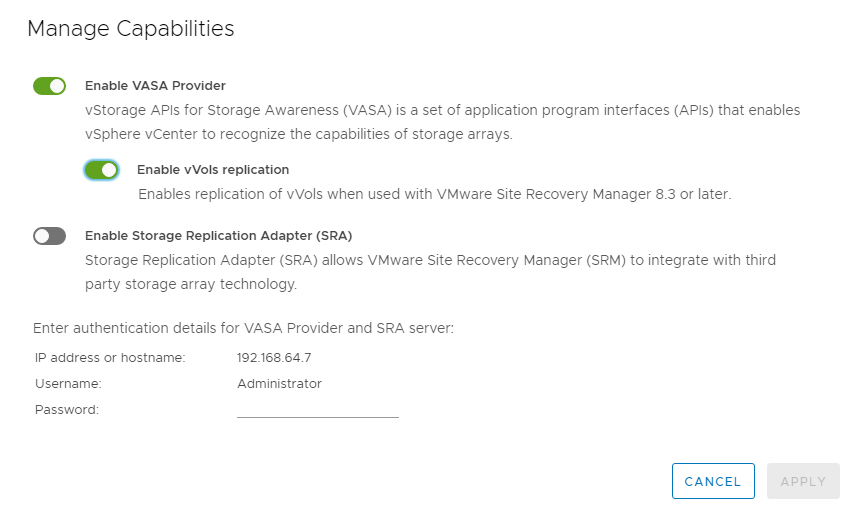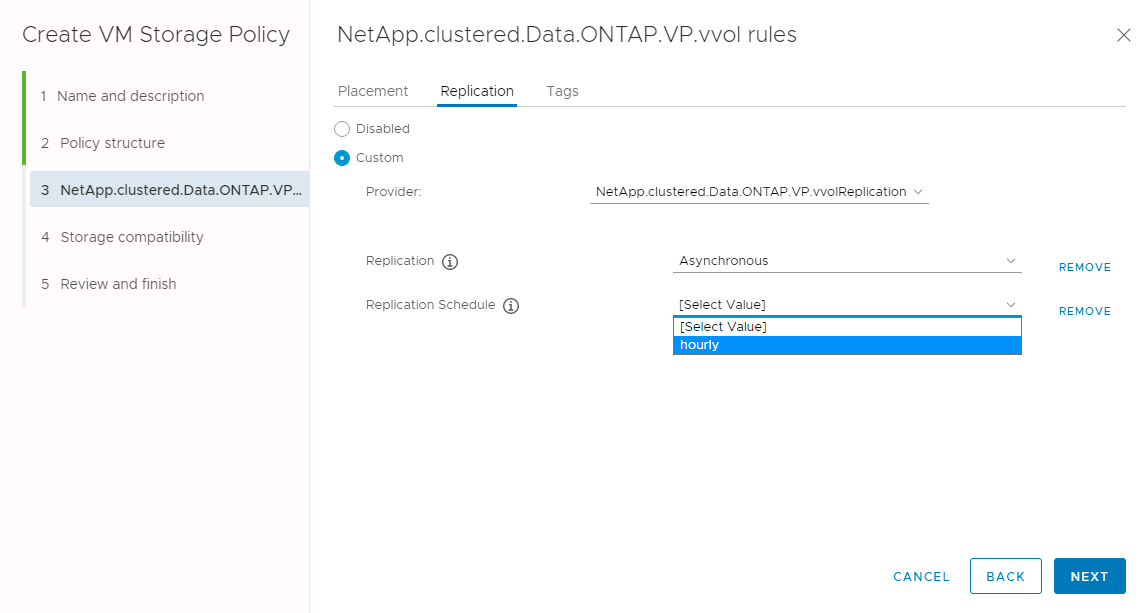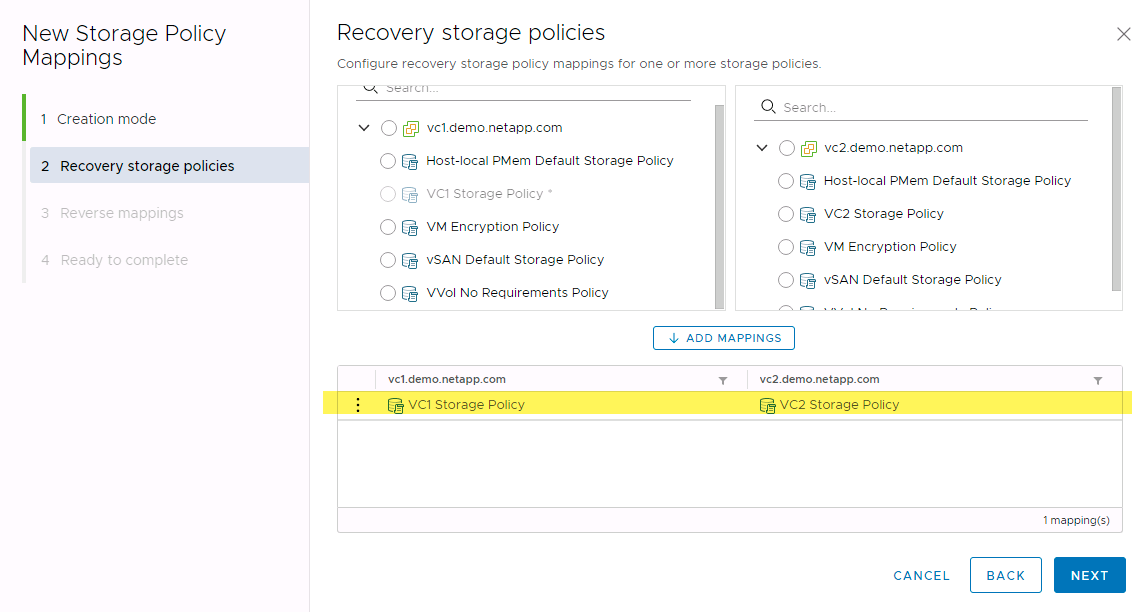Technical materials and best practices
Operational best practices
Datastores and protocols
If possible, always use ONTAP tools to provision datastores and volumes. This makes sure that volumes, junction paths, LUNs, igroups, export policies, and other settings are configured in a compatible manner.
SRM supports iSCSI, Fibre Channel, and NFS version 3 with ONTAP 9 when using array-based replication through SRA. SRM does not support array-based replication for NFS version 4.1 with either traditional or vVols datastores.
To confirm connectivity, always verify that you can mount and unmount a new test datastore at the DR site from the destination ONTAP cluster. Test each protocol you intend to use for datastore connectivity. A best practice is to use ONTAP tools to create your test datastore, since it is doing all the datastore automation as directed by SRM.
SAN protocols should be homogeneous for each site. You can mix NFS and SAN, but the SAN protocols should not be mixed within a site. For example, you can use FCP in site A, and iSCSI in site B. You should not use both FCP and iSCSI at site A. The reason for this is that the SRA does not create mixed igroups at the recovery site and SRM does not filter the initiator list given to the SRA.
Whenever possible, and if given cluster scoped credentials, ONTAP tools will still choose to load balance across LIFs local to the data, but it is not a requirement for high availability or performance.
ONTAP 9 can be configured to automatically remove Snapshot copies to preserve uptime in the event of an out-of-space condition when autosize is not able to supply sufficient emergency capacity. The default setting for this capability does not automatically delete the Snapshot copies that are created by SnapMirror. If SnapMirror Snapshot copies are deleted, then the SRA cannot reverse and resynchronize replication for the affected volume. To prevent ONTAP from deleting SnapMirror Snapshot copies, configure the Snapshot autodelete capability to try.
snap autodelete modify -volume -commitment try
Volume autosize should be set to grow for volumes containing SAN datastores and grow_shrink for NFS datastores. Refer to the ONTAP Command reference for specific syntax.
SPBM and vVols
Starting with SRM 8.3, protection of VMs using vVols datastores is supported. SnapMirror schedules are exposed to VM storage policies by the VASA Provider when vVols replication is enabled in the ONTAP tools settings menu, as shown in the following screenshots.
The following example show the enablement of vVols replication.

The following screenshot provides an example of SnapMirror schedules displayed in the Create VM Storage Policy wizard.

The ONTAP VASA Provider supports failover to dissimilar storage.
Regardless of storage similarity, you must always configure storage policy mappings and reverse mappings for replication-enabled VM storage policies to make sure that services provided at the recovery site meet expectations and requirements. The following screenshot highlights a sample policy mapping.

Create replicated volumes for vVols datastores
Unlike previous vVols datastores, replicated vVols datastores must be created from the start with replication enabled, and they must use volumes that were pre-created on the ONTAP systems with SnapMirror relationships. This requires pre-configuring things like cluster peering and SVM peering. These activities should be performed by your ONTAP administrator, because this facilitates a strict separation of responsibilities between those who manage the ONTAP systems across multiple sites and those who are primarily responsible for vSphere operations.
This does come with a new requirement on behalf of the vSphere administrator. Because volumes are being created outside the scope of ONTAP tools, it is unaware of the changes your ONTAP administrator has made until the regularly scheduled rediscovery period. For that reason, it is a best practice to always run rediscovery whenever you create a volume or SnapMirror relationship to be used with vVols. Simply right click on the host or cluster and select ONTAP tools > Update Host and Storage Data, as shown in the following screenshot.

One caution should be taken when it comes to vVols and SRM. Never mix protected and unprotected VMs in the same vVols datastore. The reason for this is that when you use SRM to failover to your DR site, only those VMs that are part of the protection group are brought online in DR. Therefore, when you reprotect (reverse the SnapMirror from DR back to production again), you may overwrite the VMs that were not failed over and could contain valuable data.
About array pairs
An array manager is created for each array pair. With SRM and ONTAP tools, each array pairing is done with the scope of an SVM, even if you are using cluster credentials. This allows you to segment DR workflows between tenants based on which SVMs they have been assigned to manage. You can create multiple array managers for a given cluster, and they can be asymmetric in nature. You can fan out or fan in between different ONTAP 9 clusters. For example, you can have SVM-A and SVM-B on Cluster-1 replicating to SVM-C on Cluster-2, SVM-D on Cluster-3, or vice-versa.
When configuring array pairs in SRM, you should always add them in SRM the same way as you added them to ONTAP Tools, meaning, they must use the same username, password, and management LIF. This requirement ensures that SRA communicates properly with the array. The following screenshot illustrates how a cluster might appear in ONTAP Tools and how it might be added to an array manager.

About replication groups
Replication groups contain logical collections of virtual machines that are recovered together. The ONTAP tools VASA Provider automatically creates replication groups for you. Because ONTAP SnapMirror replication occurs at the volume level, all VMs in a volume are in the same replication group.
There are several factors to consider with replication groups and how you distribute VMs across FlexVol volumes. Grouping similar VMs in the same volume can increase storage efficiency with older ONTAP systems that lack aggregate- level deduplication, but grouping increases the size of the volume and reduces volume I/O concurrency. The best balance of performance and storage efficiency can be achieved in modern ONTAP systems by distributing VMs across FlexVol volumes in the same aggregate, thereby leveraging aggregate level deduplication and gaining greater I/O parallelization across multiple volumes. You can recover VMs in the volumes together because a protection group (discussed below) can contain multiple replication groups. The downside to this layout is that blocks might be transmitted over the wire multiple times because volume SnapMirror doesn’t take aggregate deduplication into account.
One final consideration for replication groups is that each one is by its nature a logical consistency group (not to be confused with SRM consistency groups). This is because all VMs in the volume are transferred together using the same snapshot. So if you have VMs that must be consistent with each other, consider storing them in the same FlexVol.
About protection groups
Protection groups define VMs and datastores in groups that are recovered together from the protected site. The protected site is where the VMs that are configured in a protection group exist during normal steady-state operations. It is important to note that even though SRM might display multiple array managers for a protection group, a protection group cannot span multiple array managers. For this reason, you should not span VM files across datastores on different SVMs.
About recovery plans
Recovery plans define which protection groups are recovered in the same process. Multiple protection groups can be configured in the same recovery plan. Also, to enable more options for the execution of recovery plans, a single protection group can be included in multiple recovery plans.
Recovery plans allow SRM administrators to define recovery workflows by assigning VMs to a priority group from 1 (highest) to 5 (lowest), with 3 (medium) being the default. Within a priority group, VMs can be configured for dependencies.
For example, your company could have a tier-1 business critical application that relies on a Microsoft SQL server for its database. So, you decide to place your VMs in priority group 1. Within priority group 1, you begin planning the order to bring up services. You probably want your Microsoft Windows domain controller to boot up before your Microsoft SQL server, which would need to be online before your application server, and so on. You would add all these VMs to the priority group and then set the dependencies, because dependencies only apply within a given priority group.
Test failover
As a best practice, always perform a test failover whenever a change is made to the configuration of a protected VM storage. This ensures that, in the event of a disaster, you can trust that Site Recovery Manager is able to restore services within the expected RTO target.
Recommends confirming in-guest application functionality occasionally, especially after reconfiguring VM storage.
When a test recovery operation is performed, a private test bubble network is created on the ESXi host for the VMs. However, this network is not automatically connected to any physical network adapters and therefore does not provide connectivity between the ESXi hosts. To allow communication among VMs that are running on different ESXi hosts during DR testing, a physical private network is created between the ESXi hosts at the DR site. To verify that the test network is private, the test bubble network can be separated physically or by using VLANs or VLAN tagging. This network must be segregated from the production network because as the VMs are recovered, they cannot be placed on the production network with IP addresses that could conflict with actual production systems. When a recovery plan is created in SRM, the test network that was created can be selected as the private network to connect the VMs to during the test.
After the test has been validated and is no longer required, perform a cleanup operation. Running cleanup returns the protected VMs to their initial state and resets the recovery plan to the Ready state.
Failover considerations
There are several other considerations when it comes to failing over a site in addition to the order of operations mentioned in this guide.
One issue you might have to contend with is networking differences between sites. Some environments might be able to use the same network IP addresses at both the primary site and the DR site. This ability is referred to as a stretched virtual LAN (VLAN) or stretched network setup. Other environments might have a requirement to use different network IP addresses (for example, in different VLANs) at the primary site relative to the DR site.
VMware offers several ways to solve this problem. For one, network virtualization technologies like VMware NSX-T Data Center abstract the entire networking stack from layers 2 through 7 from the operating environment, allowing for more portable solutions. You can read more about NSX-T options with SRM here.
SRM also gives you the ability to change the network configuration of a VM as it is recovered. This reconfiguration includes settings such as IP addresses, gateway address, and DNS server settings. Different network settings, which are applied to individual VMs as they are recovered, can be specified in the property’s settings of a VM in the recovery plan.
To configure SRM to apply different network settings to multiple VMs without having to edit the properties of each one in the recovery plan, VMware provides a tool called the dr-ip-customizer. For information on how to use this utility, refer to VMware’s documentation here.
Reprotect
After a recovery, the recovery site becomes the new production site. Because the recovery operation broke the SnapMirror replication, the new production site is not protected from any future disaster. A best practice is to protect the new production site to another site immediately after a recovery. If the original production site is operational, the VMware administrator can use the original production site as a new recovery site to protect the new production site, effectively reversing the direction of protection. Reprotection is available only in non-catastrophic failures. Therefore, the original vCenter Servers, ESXi servers, SRM servers, and corresponding databases must be eventually recoverable. If they are not available, a new protection group and a new recovery plan must be created.
Failback
A failback operation is fundamentally a failover in a different direction than before. As a best practice, you verify that the original site is back to acceptable levels of functionality before attempting to failback, or, in other words, failover to the original site. If the original site is still compromised, you should delay failback until the failure is sufficiently remediated.
Another failback best practice is to always perform a test failover after completing reprotect and before doing your final failback. This verifies that the systems in place at the original site can complete the operation.
Reprotecting the original site
After failback, you should confirm with all stake holders that their services have been returned to normal before running reprotect again,
Running reprotect after failback essentially puts the environment back in the state it was in at the beginning, with SnapMirror replication again running from the production site to the recovery site.
